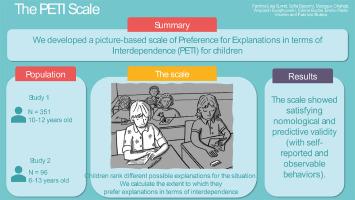从相互依存到亲环境行为:开发和验证儿童 "偏好相互依存解释(PETI)"量表
IF 2.2
Current research in ecological and social psychology
Pub Date : 2024-01-01
DOI:10.1016/j.cresp.2024.100207
引用次数: 0
摘要
相互依存是指实体之间的相互依赖,是理解社会和自然环境中发生的相互作用的一个关键概念。我们认为,从相互依存的角度来理解社会和自然现象,可以预测儿童的亲环境行为(PEBs)。现有文献显示,缺乏促进儿童亲环境行为的研究。我们首先回顾了关于相互依存的文献,以说明为什么相互依存是一个理论上可行的促进儿童亲环境行为的概念。其次,我们发现缺乏测量儿童对相互依赖解释的偏好的工具。因此,在研究 1 中,我们开发并使用了一个 9 个项目的基于小故事的量表,该量表结合了各种解释的图片和日常生活情境,即 "相互依赖解释偏好量表"(Preference for Explanations in terms of Interdependence scale-PETI),对 351 名瑞士小学生(10-12 岁)进行了测量。探索性因子分析显示该量表具有一维结构。分析表明,该量表(对自我报告的行为)具有令人满意的名义有效性和预测有效性。研究 2(N = 96)在娱乐场所进行,旨在将 PETI 量表的预测有效性扩展到实际行为。与我们的预期相反,结果显示 PETI 分数没有直接影响,但年龄具有显著的主效应,PETI 与年龄之间具有显著的交互效应,表明年龄较大(10-13 岁)的儿童比年龄较小(6-9 岁)的儿童的 PETI 与 PEB 更有正相关性。可靠性分析表明,PETI 量表更适合 10 岁及以上儿童使用。我们讨论了 PETI 量表在研究儿童对相互依存的理解与对 PEB 的认可之间的关系方面的实用性。本文章由计算机程序翻译,如有差异,请以英文原文为准。

From interdependence to pro-environmental behavior: Development and validation of the Preference for Explanations in Terms of Interdependence (PETI) scale for children
Interdependence, a mutual dependence between entities, is a key concept to understand interactions occurring in social and natural environments. We argue that understanding social and natural phenomena in terms of interdependence could predict children's pro-environmental behaviors (PEBs). The existing literature reveals a lack of studies promoting PEBs among children. We first reviewed the literature on interdependence to demonstrate why it is a theoretically viable construct to foster PEBs in children. Second, we identified a lack of instruments to measure children's preference for explanations in terms of interdependence. Thus, in study 1, we developed and administered a 9-item vignette-based scale combining pictures and everyday situations with various explanations, the Preference for Explanations in Terms of Interdependence scale—PETI to 351 Swiss pupils (10-12 years old). Exploratory factor analysis revealed a one-dimensional structure. Analyses showed satisfying nomological and predictive validity (on self-reported behaviors). Study 2 (N = 96) was conducted at recreational areas and aimed at extending the predictive validity of the PETI scale to actual behaviors. Contrary to our expectations, results revealed no direct effect of the PETI score, but a significant main effect of age, and a significant interaction effect between PETI and age showing that PETI was more positively associated to PEBs for older (10-13 years old) than for younger (6-9 years old) children. Reliability analyses suggested that the PETI scale is better suited for children aged 10 and over. We discuss the utility of the PETI scale in studying the relationship between children's understanding of interdependence and the endorsement of PEBs.
求助全文
通过发布文献求助,成功后即可免费获取论文全文。
去求助
来源期刊

Current research in ecological and social psychology
Social Psychology
CiteScore
1.70
自引率
0.00%
发文量
0
审稿时长
140 days
 求助内容:
求助内容: 应助结果提醒方式:
应助结果提醒方式:


